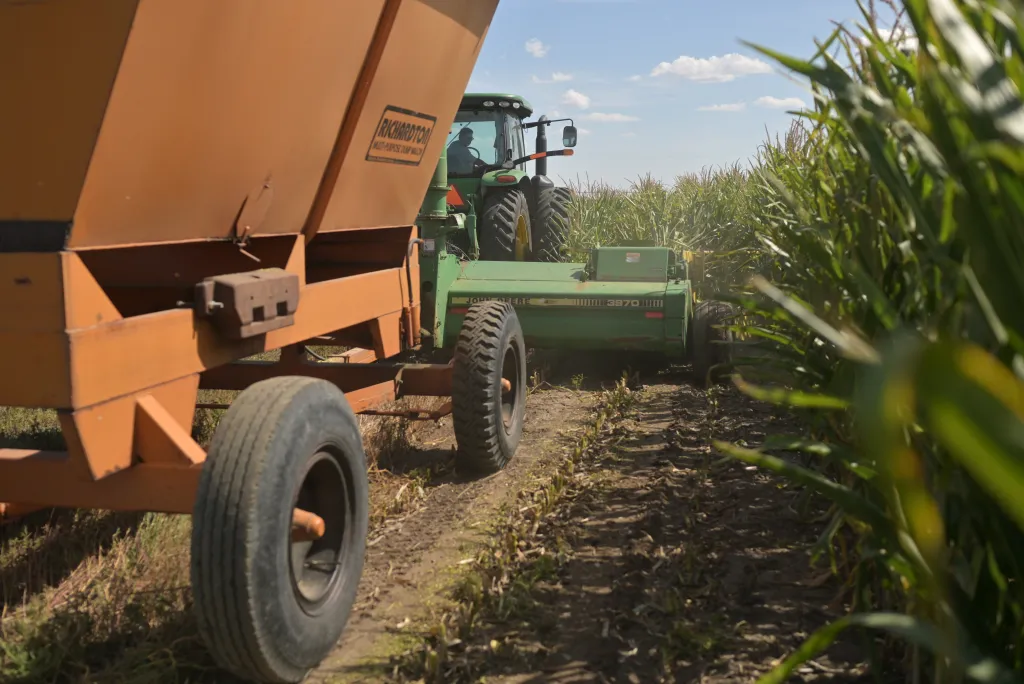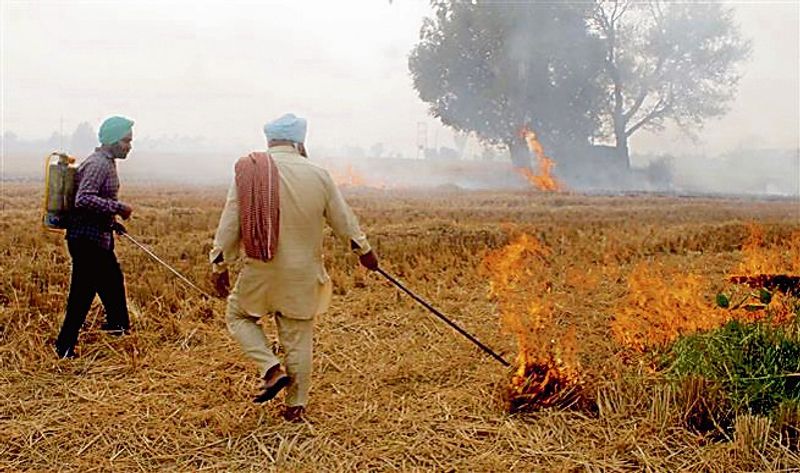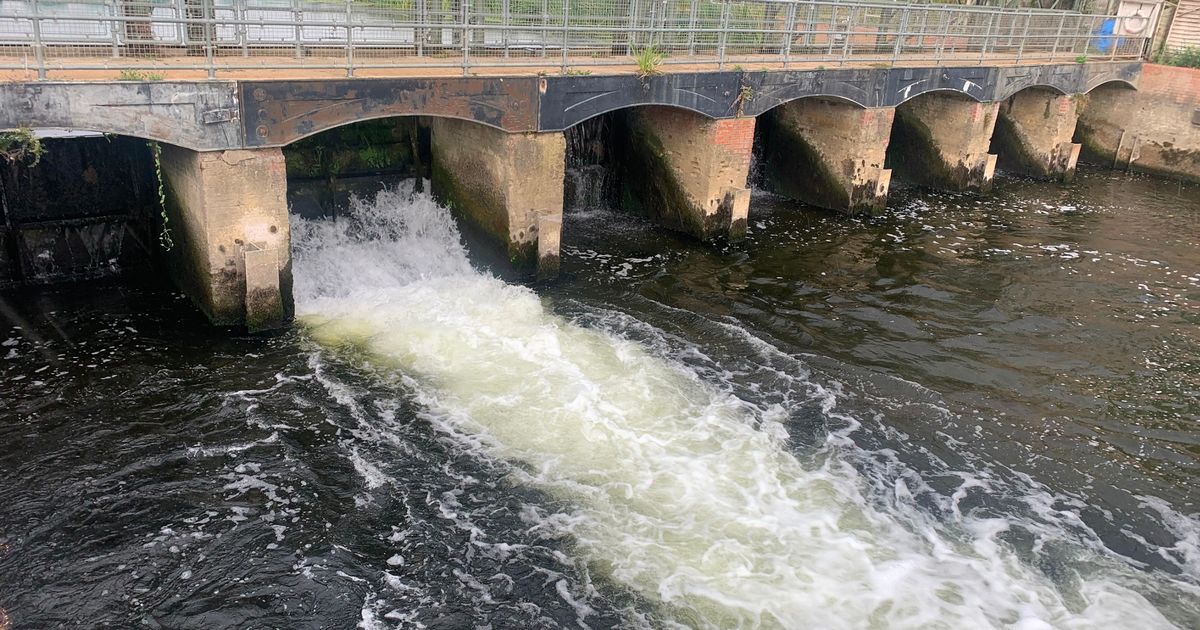
JULESBURG — The town hall in the far-northeastern corner of the state wasn’t billed as specific to one topic, but as soon as Colorado’s attorney general opened the floor to questions, there was clearly a dominant one on the minds of many in rural Sedgwick County.
“Are we going to lose our water?” a woman seated near the front asked at the event earlier this month — the first question of the night.
Residents of the Eastern Plains community have found themselves caught in the middle of a political dispute over water between Nebraska and Colorado. Nebraska’s renewed plans to build the Perkins County Canal — named for the county just over the border — could divert much of the South Platte River winter water supply relied upon by the area’s agricultural economy.
Some landowners have also faced unprecedented threats by the Nebraska state government to use eminent domain to seize the land needed for the canal in Colorado if they don’t willingly sell.
The conflict over the South Platte River and the construction of a canal across the states’ border has simmered for years, though officials in Colorado have dismissed the plans as “a political stunt” and a “boondoggle,” while also characterizing them as “unwise” and “unlikely.” But the issue boiled over this summer when Nebraska surprised Colorado leaders and took the fight to the U.S. Supreme Court.
The Cornhusker State alleged that Colorado was violating the century-old river compact between the states by failing to send enough water across the state line and interfering in the construction of the canal — the creation of which is outlined in the compact.
“We’re here to put our gloves on,” Nebraska Gov. Jim Pillen said during a July 16 news conference announcing the lawsuit. “We’re going to fight like heck. We’re going to get every drop of water.”
Colorado’s leadership has rejected the allegations and called the lawsuit a waste of time and money. At the town hall in Julesburg on Sept. 8, Colorado Attorney General Phil Weiser pledged to fight for the state’s water supplies and promised to protect rural and agricultural communities.
“We cannot be afraid to litigate or fight for our rights in Colorado,” he said. “I’ve gone to court against Google, against the United States. Going against Nebraska? I’m not concerned about that.”
The litigation is another example of power struggles over water that Colorado faces both internally and externally as growth drives more demand, while climate change and the long-term drawdown of groundwater sap the available supply. Within Colorado, cities compete with farmers and the Front Range with the Western Slope. Externally, Colorado is contending with neighboring states on how to share the South Platte, the Colorado River and the Republican River.
“You’re not alone in the state dealing with these challenging issues,” Weiser told the audience in Julesburg.
But those who call the state’s far-northeastern corner home worry that they’ll be alone in bearing the brunt of the fallout.
“This is a conflict between the states of Nebraska and Colorado,” Sedgwick County Commissioner John Fryar said. “But it’s really about water use on the Front Range and how it trickles down through the South Platte and gets to Nebraska. We just end up being collateral damage.”
“It’s really not about us — we just end up being roadkill,” he added.
Resurrection of a century-old plan
The South Platte River originates in the Front Range mountains before flowing through Denver and cutting across the northeast portion of the state. After passing through Sterling and Julesburg, it crosses into Nebraska.
The river is a critical powerhouse for Front Range cities and fuels a robust agricultural economy on the Eastern Plains. More than 85% of the state’s population lives in the river basin, and the river irrigates more than 850,000 acres of farmland — the highest concentration of irrigated acres of any river basin in Colorado. The South Platte provides, on average, half of the annual supply for Denver Water, which provides water to 1.5 million people across the metro, according to the utility.
Colorado water leaders identified the growing urban corridor as a primary challenge for the river basin. The Colorado Water Plan estimates up to 6.5 million people could live in the basin by 2050 — a 71% increase from the 3.8 million residents in 2015, when the state’s first water plan was authored. Even though per-capita water usage is expected to fall, the addition of hundreds of thousands of new users will drive up demand.
Nebraska leaders resurrected the long-dormant plans for the canal in 2022, after Colorado water leaders outlined plans to use and store more water from the river. Representatives from Nebraska’s Department of Water, Energy and Environment — which is leading the project — did not respond to multiple interview requests, but state leaders have said the canal is necessary to ensure Nebraska can protect its water supplies even as Colorado’s demand increases, especially along the urban Front Range.
“Colorado’s ongoing water development — they want it all,” Pillen said at the July news conference. “They have no interest in anything being fair and just. They want absolutely everything.”
Nebraska state leaders have pondered the creation of the Perkins County Canal for more than a century. Now they’ve set aside $628 million for the project, which would allow the state to divert water from the South Platte during the winter months.
Permission for the canal is enshrined in the 1923 South Platte River Compact, which dictates how Nebraska and Colorado share the river. The canal would begin on the South Platte south of the town of Ovid and direct the water alongside the river for more than 12 miles, until it crosses the border — where it would be stored in reservoirs. The water would drain back into the river on the Nebraska side.
The compact says Colorado “grants to Nebraska and its citizens the right to acquire by purchase, prescription, or the exercise of eminent domain such rights-of-way, easements or lands as may be necessary for the construction, maintenance, and operation of said canal.”
The compact states that Nebraska can use the canal for irrigation, though state leaders have said it will also increase water supplies for its capital and second-largest city, Lincoln.
Nebraska’s lawsuit alleges that Colorado is violating the compact by not allowing enough water to cross the border and by blocking progress on the canal. The state is asking the Supreme Court to create a procedure for Nebraska to use eminent domain in Colorado and to enforce the compact rules.
“Colorado has breached that Compact, and its actions threaten to drastically curtail Nebraska’s access to water from the South Platte River,” the lawsuit states. “These breaches have harmed Nebraska and pose a significant, ongoing threat to Nebraska, from its agricultural economy to the water security of its major population centers.”
Threat of eminent domain looms
But before the matter landed in the nation’s highest court, it prompted alarm on the ground when a smattering of Sedgwick County landowners received startling letters in January.
The letters from Nebraska’s Department of Natural Resources made offers on land the state needed to build the canal and opened the door for purchase negotiations.
But they also included a threat.
“In the event we are not able to reach a negotiated purchase of the necessary property interests, this letter additionally serves the purpose of notifying you of the State’s intention to initiate formal condemnation proceedings,” one such letter stated, giving the landowner an April 17 deadline to decide.
Nebraska had little success.
Sedgwick County property records show that one landowner sold about 90 acres to the Nebraska resources department in 2023.
But the other Colorado property owners organized. And they hired an attorney.
Sedgwick County Commissioner Ronald Berges said his 95-year-old uncle was one of the people who received Nebraska’s letter. His reaction? “As the old guys are fond of saying, he said: ‘Go fly a kite,’ ” Berges recalled.
Donald Ostrander, the attorney representing 22 landowners whose properties Nebraska alleges are necessary for the construction of the canal, fired back at the Cornhusker State. If Nebraska pursues eminent domain proceedings, he wrote in a letter to the state, it must use Colorado’s condemnation procedures and follow its laws, which are more protective of landowners. Colorado law requires that entities using eminent domain not only pay for the taken property itself, but also the loss in value to what remains of that property.
If constructed, the canal would dry up between 30,000 and 60,000 acres of irrigated farmland across Sedgwick, Logan and Washington counties, Ostrander said in his March response to Nebraska. The change would cause between $135 million and $270 million in lost property value in the region, since the canal would reduce the winter flows used by farmers to replenish supplies.
Those figures do not include potential impacts to 40 municipal wells that use water from the river.
“It would almost be impossible to calculate the cumulative effect the loss of this water supply would have on Sedgwick County and its residents,” Ostrander wrote in his letter, noting each landowner and every town would have a damage claim against Nebraska. “The economic impact of such a loss on Sedgwick County and Northern Colorado would be devastating.”
Nebraska withdrew its notifications of intent to use eminent domain when it filed its lawsuit to the Supreme Court, Ostrander said.
Now, the landowners wait in limbo.
“We have this cloud hanging over our heads of not knowing what they can do with their property — not knowing what their future water will look like for farming and ranching,” Ostrander said.
‘An unusable wasteland’
If the canal goes through, it would affect not only people who would lose their land but also thousands of people with wells along the river and two of the three towns in the county, which rely on wells for drinking water.
“You’d be talking about potentially turning everything from the west side of Ovid to the stateline into almost an unusable wasteland,” Sedgwick County Commissioner Darrin Tobin said.
Irrigators and others draw from the river in the winter and fill ponds that eventually allow the water to seep back into the river through the ground. This system — called augmentation — allows farmers to use more water during the irrigation season, as they essentially pay back the water when it is in less demand.
If the canal is built, however, Nebraska will use much of the winter river flow that Coloradans rely on for their recharge — reducing the amount of water they can use during the irrigation season.
Donald Schneider grows corn, wheat, alfalfa and soybeans, and he operates seven augmentation ponds that would likely be useless if the canal is built. The conflict over the compact has left him deeply uncertain and worried for the future of his farm operations.
“It’s mind-boggling how they can come back after 100 years and expect to be able to put that canal in,” he said. “It’s just a scary situation.”
Without augmentation, irrigated farmland would turn to dry land. Without irrigation water, the land would be worth less. And when land is worth less, Sedgwick County loses the property tax dollars it relies on for basic services like law enforcement and roads, said Fryar, the county commissioner.
“We’re already one of the poorest counties in the state. Our income per capita is low,” he said. “If you take away irrigated ground, that not only affects tax evaluations and the cost of living for the people who are here, but it would significantly affect the county’s ability just to provide basic services.”
Residents also fear the canal would bore through the area’s historic sites, many of which played critical roles in the country’s western expansion.
During a joint interview, Anna Scott and Jeana Johnson quickly ticked off historic sites and important places that could be impacted by the canal: the Pony Express trail, the California-Oregon trail, the military ground once occupied by Fort Sedgwick, and two previous sites of the town of Julesburg. Scott works with the South Platte River Trail Scenic and Historic Byway, a 19-mile loop of historic sites between Julesburg and Ovid, and Johnson is with the Sedgwick County Historical Society.
Final plans for the canal have not been finalized, but if Nebraska follows its original course, the canal would go straight through the Colorado Welcome Center in Julesburg — visited by hundreds of thousands of people every year — and might clip the town’s cemetery, too.
“A lot of the western part of our nation went right through here,” said David Kinnison, also from the byway group. “That’s awesome in my mind, what this area actually says in our history. If this area could talk, what could it tell us?”
The group worries it will impact the byway, which the state estimates generates more than $1.7 million annually for the local economy. It’s also important for locals, Scott said.
“I want everyone who lives here to be proud of where they come from, to know that we were significant in the making of America,” she said. “From the trails to the nation, we helped build it.”
Future in limbo
The state of Colorado has until Oct. 15 to file a response to Nebraska in the Supreme Court, and Nebraska will get a chance to file a final response. Then the justices will decide whether to take on all, some or none of the issues raised.
Weiser doesn’t think the court will take the case, or even part of it. His office plans to argue in its response to the Supreme Court that it should not consider the case because the lawsuit is premature.
“It’s not based on a real plan, it’s based on a plan to plan — and that’s putting it generously,” Weiser said.
If the court takes the case, it would take three to five years to resolve the matter, according to Nebraska’s attorney general, Michael Hilgers. In the meantime, Nebraska will pursue permits and plans for the canal, he said.
Weiser thinks litigation could span decades. If the court doesn’t take the case, Weiser hopes the states can negotiate a solution.
“They’ve done more than I thought they would and I’m sorry this is playing out the way it is, as opposed to the way I’d like it to,” he said at the Julesberg event. “But we will do our best to roll with whatever steps they take and, at some point, I believe this will be settled at the negotiating table. I don’t know how long it’s going to take, though. Or what’s going to have to happen before then.”
Schneider worries that far-northeast Colorado will take the brunt of the negative impact from whatever deal or settlement the two states reach for the water he relies on for his livelihood. He doesn’t trust Colorado leaders to keep the best interests of the rural corner in focus.
“When the state starts to talk about negotiating,” he said, “it gives me cold chills.”



